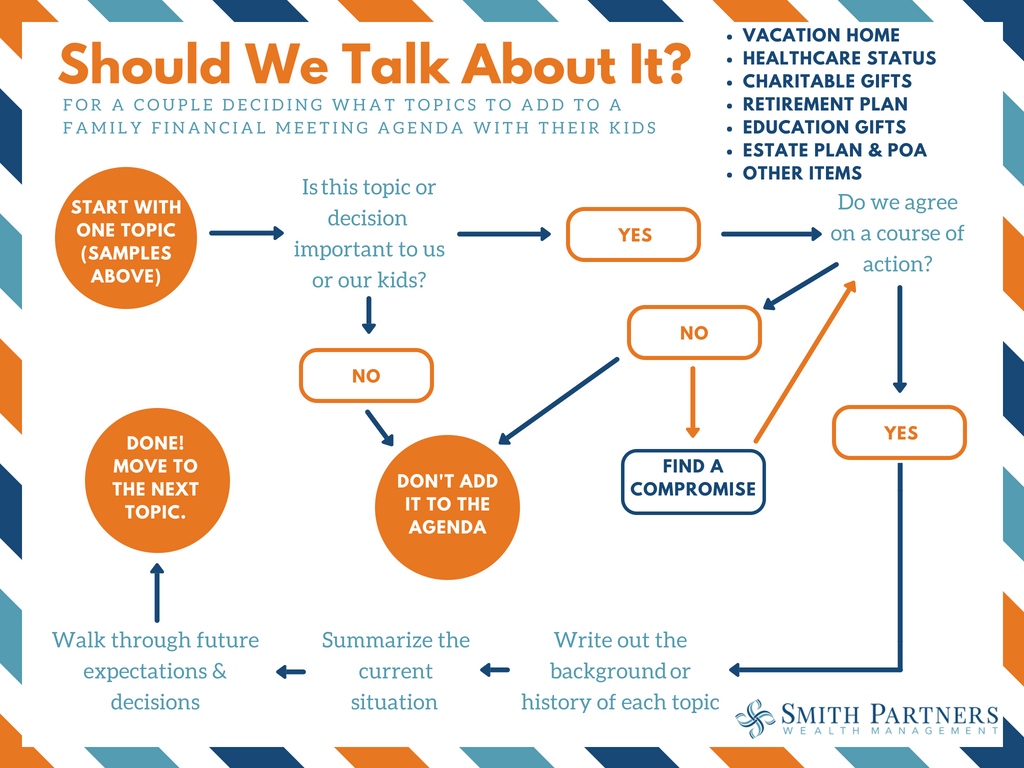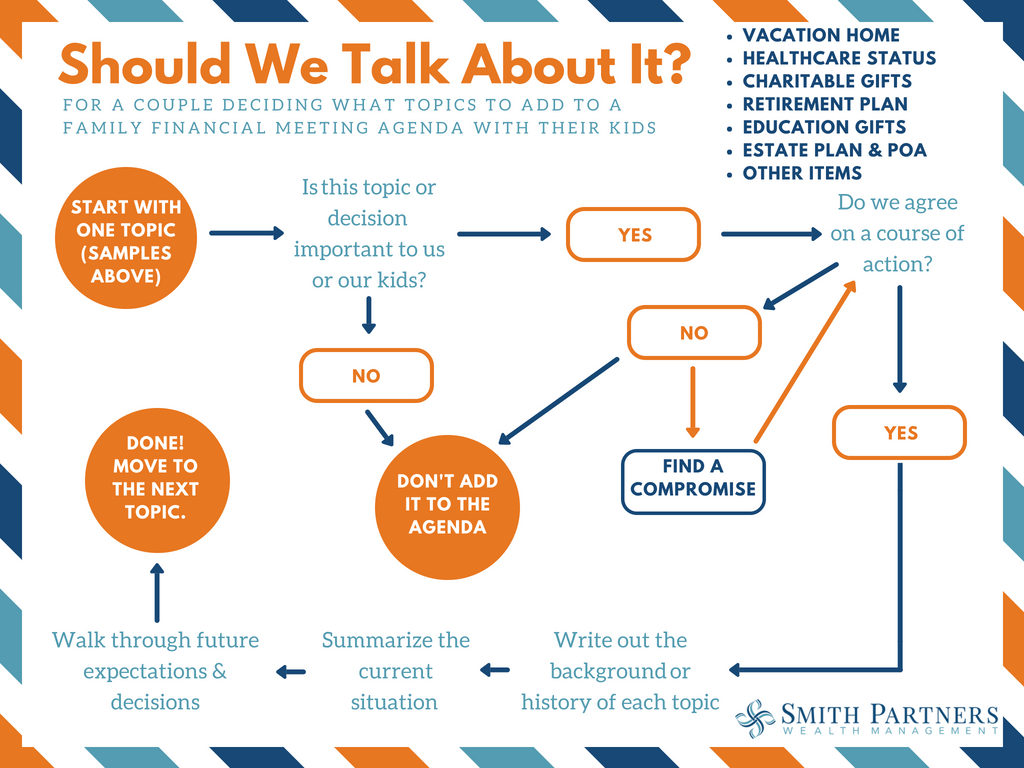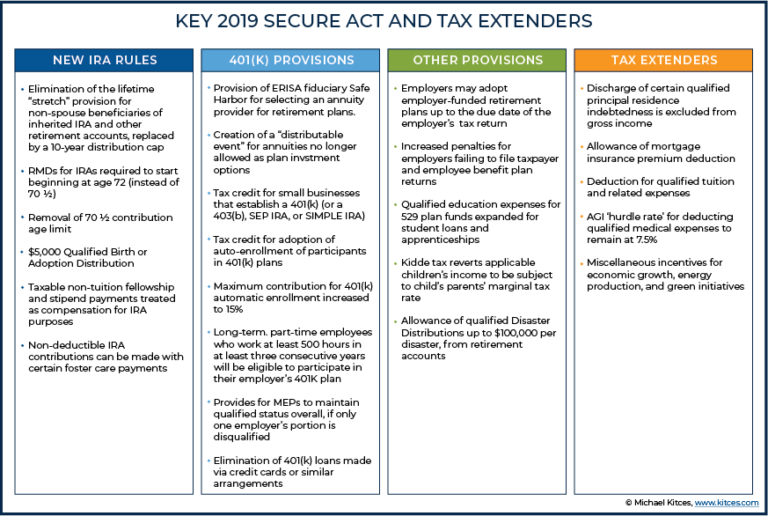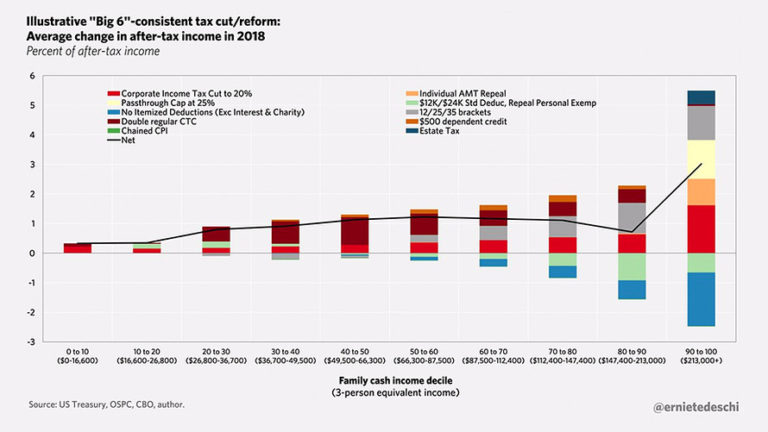A Step by Step Guide to Having a Family Money Talk
If you’re not already there, it’ll happen to you soon. You’ll need to have a Family Money Talk. Maybe you’re in your 20s asking your parents how much they could pay for a wedding. Or you could be in your 40s talking to your kids about their college choices. Our most frequent case, the one we detail below, is the Mom and Dad in their late 60s talking to their kids about their financial plan, but feel free to use this framework to fit your own situation.
First, a note about the level of detail below. One of my life goals is to be able to give a great impromptu monologue like Jack Pearson on NBC’s “This is Us” but that’s not real life. A successful Family Money Talk requires some intentional planning and it doesn’t come easy…but is well worth it.

Focus Only on Important Topics
Establish a list of possible topics, narrowing it down to the 5 (or fewer) most important. These could be broad topics like Overall Financial Plan or Retirement Dreams, but they could also be specific like Charitable Giving or Vacation House Plan. We also encourage families to cover topics that might not seem “financial” in nature such as Health or Personal Belongings.
Establish Consensus
Once we decide on the key topics to discuss, Mom and Dad must then come to an agreement on their “position” within each topic.
For example, if Mom and Dad would like to talk about making financial gifts to family members, they must agree on subtopics like: how much money to give, will these gifts be recurring, how long will we give the gifts, and are there any stipulations on how the money is spent.
Let’s say that Mom and Dad agree that they would like to give $5,000 to each of their kids, but they disagree on how often they want to make the gifts. Mom wants to give every year, but Dad wants to give once and revisit it every year. As the advisor, we would ask the clients to talk about the underlying reasons behind their respective positions. If that conversation convinces the other to change their position, then we have agreement.
However, if Mom and Dad still don’t see eye to eye, the next step is to find a compromise before the family meeting. That could mean choosing the more conservative option or possibly communicating a “wait and see” approach. For our example, Mom and Dad agree on the statement “We would like to give similar gifts in the future, but we don’t know the amount or frequency. We’ll have to see what our financial plan looks like over time.”
You Can Agree to Disagree…But Not at the Meeting
If we come to an agreement, write it down word for word and have both Mom and Dad “sign off” on it. But, if consensus still isn’t met, we need to agree to not cover that topic in the actual family meeting.
This isn’t because we need to shield the kids from Mom and Dad arguing (chances are, they have seen plenty of that over the years). Rather, if the hope of a family meeting is to provide clarity, then talking through topics where there is no consensus could create confusion (at best) or a “good guy/bad guy” scenario (at worst).
The exception to this rule is if the input of the family is critical to the decision making process and both parents welcome the input of the family members. For example, let’s say Mom and Dad are undecided (and mostly indifferent) about selling the family beach house and want the kids’ input. This would be a situation where Mom and Dad can agree to disagree with the kids, because they are seeking more data to help them make a decision.
Our chart below should help
Write Out the Two Agendas
Once Mom and Dad have signed off on the topics, we will make two sets of agendas. These will include Introduction/Background, Current Situation, and Future Expectation/Decisions for each topic (more of this below).
The “Parent’s Agenda” will be for Mom and Dad, it will include 100% of what they will talk about AND (if they need a reminder) 100% of what they won’t talk about. The latter will be clearly defined by color, type font, or giant Xs. This agenda will serve as a detailed map of both where to step and what to avoid. The “Kid’s Agenda” will be for everyone else and will include only the main topics and potentially some subtopic headings but no details.
The Invitation
Gathering everyone involved can be the hardest part of this process. Ideally everyone should be there in person, but bringing someone in via Skype could work also. Make sure to communicate why you’re having this meeting and your desired outcome. And unless you have some big negative surprise to reveal (health or otherwise) be sure to alay that fear as part of your invitation.
In practice, it could go something like: “Your Dad and I want to fill you in on our retirement plan as it concerns you and your siblings. It’s something I wish my parents had done. And don’t worry, there’s no surprise medical diagnosis or anything, we just figured now would be a good time to bring you in on the conversations.”
Start the Meeting
Once everyone is gathered, it would be worth reiterating both the purpose and desired outcome of the meeting. Some families open up the meeting with a prayer or reading something meaningful to set the tone. Others might go around the room, each person giving a brief update on their past year and/or expectations of the year ahead as a way to break the ice.
Consider asking the kids or anyone else in attendance about their hopes for the meeting, but be mindful of your agenda. If something is brought up, but it is a topic or detail that you agreed not to cover, make sure to say “That’s a great point and we even talked about that beforehand. It’s important to us too, but we’re not quite ready to talk about that today. Let’s table that to the next meeting.”
We also suggest establishing solid ground rules. All families are different, but some rules to consider: only one person speaks at a time, everyone has a chance to be heard, silence phones, and commit to ending the meeting at the stated time.
One person should act as the facilitator to make sure the meeting runs smoothly. This could be Mom or Dad in this situation, but could also be a trusted family CPA, attorney, or financial advisor. We’ve played this role and found that it is helpful for many of our clients.
Going Through The Agenda
Give a brief overview of each topic as seen on the Kid’s Agenda, then begin with Topic One. Each topic should have an Introduction/Background, Current Situation, and Future Expectation/Decisions.
For the Introduction/Background of each main topic, we would suggest that you take a storytelling approach. For example, if Mom and Dad are going to talk about Charitable Giving, they might tell the history of each of their first meaningful gifts, some of their favorite charities, or memories of how people have been generous to them. If Mom and Dad are going to talk about family gifts for education, they should talk about the role of education in their family history and why it is important. The point here is to give the “why” behind your actions, because the “why” matters much more than the “what”.
After introducing a topic, stick to the “signed off” agenda regarding the Current Situation and Future Expectations/Decisions. Often, we’ve found that the less detail and fewer promises, the better. For example if Mom and Dad want to talk about their overall financial plan, they could certainly run through the detailed financial plan with all of the numbers, investment holdings, and scenarios…but we would suggest something more simple.
For example, they could say “Our current situation is that we have enough in savings, investments and income to take care of our needs and wants for many years past our expected lifespans. In those assumptions, we account for high medical costs, conservative investment returns, and all the travel we can stand. You won’t have to worry about us.”
If appropriate, after each topic, open the floor for questions. If the conversation drifts into areas or details you didn’t agree to speak about, bring it back with a “we’re still thinking through that and maybe we can touch on it in our next meeting”.
The Next Meeting
Once you have covered all topics, open the floor again for thoughts or questions about the conversation as a whole. Consider asking if there are any additional topics the kids would like to discuss next time. We would also encourage setting the expectation for future meetings by scheduling the next one before the meeting adjourns.
If you have had family meetings we would love to hear what has gone well or poorly in them. If you would like to have one and have questions about what topics to cover or just where to start, we’d welcome the opportunity to help walk you through it.









